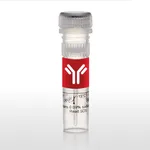
Thermo Fisher Scientific Ephrin-A5 (extracellular) Polyclonal Antibody
✨AI 추천 연관 상품
AI가 분석한 이 상품과 연관된 추천 상품들을 확인해보세요
연관 상품을 찾고 있습니다...
Applications
Tested Dilution
Publications
Western Blot (WB)
1:200
Immunohistochemistry (Frozen) (IHC (F))
1:200
Product Specifications
Species Reactivity
Human, Mouse, Rat
Host/Isotype
Rabbit / IgG
Class
Polyclonal
Type
Antibody
Immunogen
(C)DRVFDVNDKVENSLE, corresponding to amino acid residues 172-186 of human Ephrin-A5, Extracellular if (typeof window.$mangular === undefined || !window.$mangular) { window.$mangular = {}; } $mangular.antigenJson = \[{targetFamily:Ephrin A5,uniProtId:P52803-1,ncbiNodeId:9606,antigenRange:172-186,antigenLength:228,antigenImageFileName:AER-035-200UL_Ephrin_A5_P52803-1_Rabbit.svg,antigenImageFileNamePDP:AER-035-200UL_Ephrin_A5_P52803-1_Rabbit_PDP.jpeg,sortOrder:1}\]; $mangular.isB2BCMGT = false; $mangular.isEpitopesModalImageMultiSizeEnabled = true;
View immunogen .st0{fill:#FFFFFF;} .st1{fill:#1E8AE7;}
Conjugate
Unconjugated Unconjugated Unconjugated
Form
Lyophilized
Concentration
0.8 mg/mL
Purification
Antigen affinity chromatography
Storage buffer
PBS, pH 7.4, with 1% BSA
Contains
0.05% sodium azide
Storage conditions
-20° C, Avoid Freeze/Thaw Cycles
Shipping conditions
Ambient (domestic); Wet ice (international)
Product Specific Information
Reconstitution: 25 µL, 50 µL or 0.2 mL double distilled water (DDW), depending on the sample size. The antibody ships as a lyophilized powder at room temperature. Upon arrival, it should be stored at -20C. The reconstituted solution can be stored at 4C for up to 1 week. For longer periods, small aliquots should be stored at -20C. Avoid multiple freezing and thawing. Centrifuge all antibody preparations before use (10000 x g 5 min).
Target Information
Ephrin A5 is a cell surface GPI-bound ligand for Eph receptors, a family of receptor tyrosine kinases which are crucial for migration, repulsion and adhesion during neuronal, vascular and epithelial development. Binds promiscuously Eph receptors residing on adjacent cells, leading to contact-dependent bidirectional signaling into neighboring cells. The signaling pathway downstream of the receptor is referred to as forward signaling while the signaling pathway downstream of the ephrin ligand is referred to as reverse signaling. Induces compartmentalized signaling within a caveolae-like membrane microdomain when bound to the extracellular domain of its cognate receptor. This signaling event requires the activity of the Fyn tyrosine kinase. Activates the EPHA3 receptor to regulate cell-cell adhesion and cytoskeletal organization. With the receptor EPHA2 may regulate lens fiber cells shape and interactions and be important for lens transparency maintenance. May function actively to stimulate axon fasciculation. The interaction of EFNA5 with EPHA5 also mediates communication between pancreatic islet cells to regulate glucose-stimulated insulin secretion. Cognate/functional ligand for EPHA7, their interaction regulates brain development modulating cell-cell adhesion and repulsion.
For Research Use Only. Not for use in diagnostic procedures. Not for resale without express authorization.
🏷️Thermo Fisher Scientific 상품 둘러보기
동일 브랜드의 다른 상품들을 확인해보세요

Thermo Fisher Scientific
Thermo Fisher Scientific Ephrin-B1 (extracellular) Polyclonal Antibody
742,000원

Thermo Fisher Scientific
Thermo Fisher Scientific EphB4 (extracellular) Polyclonal Antibody
742,000원

Thermo Fisher Scientific
Thermo Fisher Scientific Ephrin-A5 (extracellular) Polyclonal Antibody
742,000원

Thermo Fisher Scientific
Thermo Fisher Scientific Ephrin-A2 (extracellular) Polyclonal Antibody
742,000원

Thermo Fisher Scientific
Thermo Fisher Scientific EphA4 (extracellular) Polyclonal Antibody
742,000원
배송/결제/교환/반품 안내
배송 정보
| 기본 배송비 |
| 교환/반품 배송비 |
|
|---|---|---|---|
| 착불 배송비 |
| ||
| 교환/반품 배송비 |
| ||
결제 및 환불 안내
| 결제수단 |
|
|---|---|
| 취소 |
|
| 반품 |
|
| 환급 |
|
교환 및 반품 접수
| 교환 및 반품 접수 기한 |
|
|---|---|
| 교환 및 반품 접수가 가능한 경우 |
|
| 교환 및 반품 접수가 불가능한 경우 |
|
교환 및 반품 신청
| 교환 절차 |
|
|---|---|
| 반품 절차 |
|
